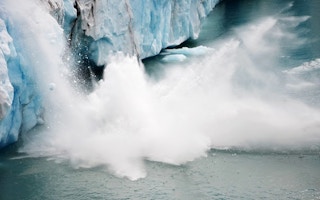The world is now halfway towards the internationally-agreed safety limit of a maximum 2°C rise in global average temperatures, researchers say.
That limit seeks to prevent the global warming caused by the burning of fossil fuels exceeding 2°C above the pre-industrial global temperature. The UN’s Paris climate summit later this year aims to ensure that it is not breached.
It appears that the human race has taken roughly 250 years to stoke global warming by 1°C. On present trends, we look likely to add the next 1°C far more quickly – across much of the world, many climate scientists believe, by the middle of this century.
The research is published in the journal New Scientist, which commissioned it. As so often with climate projections, it needs qualifying and teasing apart.
Some scientists, for example, warn that there’s uncertainty about just what the pre-industrial global temperature was. The New Scientist research is careful to be specific: it says global surface temperature is now passing 1°C of warming “relative to the second half of the 19th century”.
“
It is not difficult to imagine that conflicts arising from forced migrations and economic collapse might make the planet ungovernable, threatening the fabric of civilisation.
James Hansen, former director of NASA’s Goddard Institute for Space Studies
Farewell, hiatus
And one of the four main trackers of temperature thinks that milestone will be passed only if there is a strong El Niño, the cyclic Pacific weather phenomenon that periodically brings widespread chaos in its wake.
However, the research looks likely finally to lay to rest the argument that global warming is slowing and stuttering to a virtual halt, the so-called hiatus theory. Kevin Trenberth, of the US National Center for Atmospheric Research in Boulder, Colorado, told New Scientist: “There’s a good chance the hiatus is over.”
The hottest year since records began was – by a very small margin – 2014, and this year’s El Niño could mean a temperature rise of 0.1°C this year, an increase which usually takes about a decade to develop. Dr Trenberth thinks 2015 is likely also to be a record-breaker.
Between 1984 and 1998 the Earth warmed at 0.26°C a decade, but the Intergovernmental Panel on Climate Change (IPCC) says the rate then fell back until 2012 to about 0.04°C, for a number of reasons, including a less active Sun, more cooling aerosols from volcanoes and Asian factories, and more heat being absorbed by the oceans. The New Scientist findings suggest that warming may soon revert to the higher rate.
From a quite different source comes a warning not only that temperatures may soon start a marked rise, but that sea level may also accelerate far faster than most scientists think likely.
The prospect it holds out is at odds with most mainstream climate science, and might well be discounted as alarmist and fanciful.
But the lead author of the discussion paper in which it appears is the highly respected James Hansen, former director of NASA’s Goddard Institute for Space Studies.
He and his colleagues say the ice melting around Greenland and Antarctica will cause sea level rises much faster than mainstream predictions suggest, by several metres this century. This will add to a process which they say has already begun, accelerating the melting of the undersides of Antarctic glaciers and ice shelves.
Another consequence, they think, will be the shutting down of ocean currents which carry heat from the tropics to the polar regions, leaving the tropics to warm fast and the high latitudes to cool. This temperature difference, they say, will spawn superstorms unlike any seen so far.
All this, Professor Hansen and his colleagues say, could happen with a 2°C temperature rise, with devastating consequences: “It is not difficult to imagine that conflicts arising from forced migrations and economic collapse might make the planet ungovernable, threatening the fabric of civilisation.”
Professor Hansen may of course be wrong, but it would be short-sighted to assume that he is. He has a strong record of ultimately being proved right.










